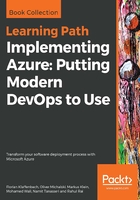
Azure Container Registry (ACR)
If you need to set up a container environment to be used by the developers in your Azure tenant, you will have to think about where to store your container images. In general, the way to do this is to provide a container registry. This registry could reside on a VM itself, but using PaaS services with cloud technologies always provides an easier and more flexible design.
This is where Azure Container Service (ACS) comes in, as it is a PaaS solution that provides high flexibility and even features such as replication between geographies.
This means you will need to fill in the following details:

When you create your container registry, you will need to define the following:
- The registry name (ending with azurecr.io)
- The resource group the registry sits in
- The Azure location
- The admin user (if you will need to log in to the registry using an account)
- The SKU:
- Basic
- Standard
- Premium
The following table details the features and limits of the basic, standard, and premium service tiers:

Switching between the different SKUs is supported and can be done using the portal, PowerShell, or CLI.
If you still are on a classic ACR, the first step would be to upgrade to a managed registry using the following steps at https://docs.microsoft.com/en-us/azure/container-registry/container-registry-upgrade.
From the best-practice point of view, you should design your ACR that way, to provide it near to the region where you are planning to deploy the containers themselves.